Success story
PowderPeaks
Learn how Influencity helped PowderPeaks initiate their first influencer seeding strategy
Summary
PowderPeak sports is an online company based in Vancouver, Canada, that specializes in snowboard gear and accessories. Since their start in 2018, they have quickly grown their online presence and are leaders in providing quality, innovative gear at an affordable price.
Target Audience
PowderPeak’s target audience is men and women aged 18-35. Their customers are based primarily in the Vancouver area; however, the brand is hoping to increase sales across Canada, the US, and beyond.
As for price points, their younger clientele usually opt for lower-priced items such as their branded hats, leisure wear, and gloves, while the more expensive items like boots, helmets, and boards are typically sold to customers between the ages of 25 and 35.
Pain Points:
Difficulty Sourcing Influencers
In past seasons, the company has tried campaigns with influencers, but with poor results. They mainly sourced talent through word of mouth and didn’t have an established search process in place. What’s more, they typically judged influencer performance based on flashy content and follower size, and lacked the tools and bandwidth to analyze the interests and demographics of their followers.
The brand considered partnering with an influencer marketing agency in the past, but was turned off by the high prices and limited number of profiles available.
The Peaks and Valleys of Seasonality
The Vancouver snowboarding season is short – usually from December to April. During the off-season, demand for snowboard gear and accessories declines and it’s hard to keep customers engaged. As most of their revenue comes in winter, they need an innovative Christmas campaign to start the season off strong, get customers excited about their products, and stand out in a crowded market.
Low Customer Lifetime Value
PowderPeaks accessories are very popular with a younger audience (18-25), but they struggle to engage this segment with their higher-tier products, such as goggles, helmets, and snowboards. They recently introduced new models—the 'Snow Sight Pro' goggles and the 'Arctic Edge Defender' helmet—both meant to be more accessible for a younger audience. However, despite positive reviews, they haven't caught on, and sales were low last year.
The company needs to get these new, lower-priced products in front of as many eyes as possible. However, as influencer seeding is often a numbers game, they are hesitant to try this popular strategy for fear of wasted time and wasted product. The logistics of these campaigns are also tricky, as they involve packaging and sending lots of products to lots of influencers.
The Influencity Solution
In August 2023, PowderPeaks decided to try an influencer marketing platform. The advantage this offered was flexibility—the pool of influencers was not limited to a small number of partners, as it often is in many agencies. Additionally, the e-commerce integrations allowed PowderPeaks to seamlessly combine the search, vetting, and seeding processes
Here’s an overview of the different Influencity products and how PowderPeaks used them to optimize their campaigns.
Finding Niche Influencers with Influencer Discover
The company’s first pain point was trouble finding influencers. Typically, they would perform searches using Instagram’s hashtag search feature, with each search taking approximately 45 minutes and yielding 4-5 results.
The solution that Influencity offered is simple: instead of reducing the pool of influencers to a group of pre-selected profiles (as is the case with many agencies) their AI-powered platform allows users to search among public profiles anywhere in the world. To narrow down this vast pool of candidates, they offer a range of filters to zero in on profiles within a specific follower range, and with a certain engagement rate, interests, and keywords used.
Here’s PowderPeaks’ first Influencity search.
Location: The company is based in Vancouver, Canada, however they would like to expand their reach into the US. As such, they set the influencer location to “Canada” and “United States”. This means that any profile in their search results would correspond to one of these locations.

Topics: This is a way to expand a search around a specific topic. When you write “snowboard”, you see a list of related keywords that are currently trending. This is a good way to see the hashtags that are being used to talk about this topic. By selecting “snowboard” we’re able to explore all profiles that relate to this topic.
Bio: The bio is the free-text space below an influencer’s profile picture. This is the area where they typically describe themselves and their content. This search would zero in on any profile with “snowboarding” in the bio.
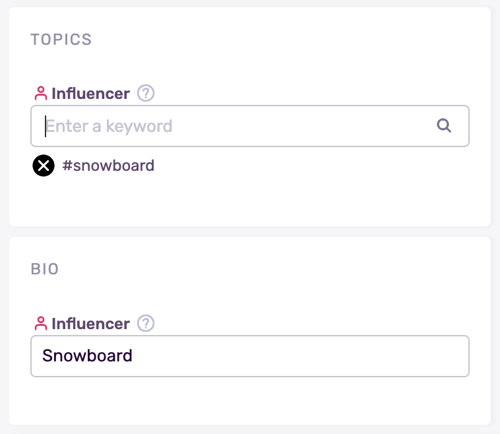
The Result: More Profiles in Less Time
With the help of these search filters, PowderPeaks was able to cut their search time in half. In just 20 minutes of testing and filter adjustments, they were able to produce a list of 18 profiles. This represents a 77% decrease in the time it takes to search for profiles.
In addition, these searches achieve many more results - 18 instead of 5 with a manual search. This represents a 260% increase in profiles.
Working with Influencers in the IRM - A Two-Step Approach
Vetting Profiles
Time is valuable and the PowderPeaks team was already busy with pre-season prep. Spending 10-15 minutes manually vetting profiles is too resource intensive (not to mention ineffective), so they needed a way to get accurate performance metrics, fast.
Using the analysis feature in Influencity’s Influencer Relationship Management (IRM) tool, PowderPeaks was able to generate a scannable page for each profile that lists key performance data, such as:
- Earned media value - the equivalent advertising value of a post. For example, collaborating with an influencer with an EMV of 500 USD would provide the same “advertising value” as 500 USD spent on paid ads. When other metrics and factors are similar, the EMV is a good way to determine which profile would bring the most advertising value.
- Follower quality - the percentage of “nice” followers (users you could convert into customers) and “doubtful” ones (bots and inactive users).
- Average activity split - the number of video views, likes and comments on an average post. These are the type of interactions you could expect if you collaborated with this influencer.
- Engagement rate - the number of interactions (likes, comments) divided by the total number of followers. This percentage is then put on a scale to compare it to the average influencer of this community size.
- Profile evolution - the number of followers, accounts followed, and likes plotted over time.
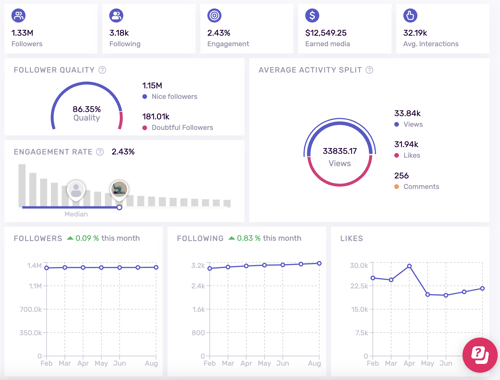
- Hashtags, mentions & brand affinity - the tags, accounts and brands that appear in their posts. This is a good way to see if an influencer has interacted with your competitors or accounts that don't match your brand values.

- Profile lookalikes - profiles that post similar content
- Audience demographics - broken down into age, gender, and country.
- Audience lookalikes - influencers who impact an audience with the same demographics.

The Result: Data At a Glance
The visual nature of this data facilitates decision making. Where it used to take about 10 minutes to review each profile and its followers, with an Influencer Relationship Management tool, a complete review can be done in 3 minutes.
In addition, this data can be easily shared, which is an effective way to keep other stakeholders informed.
Landing Page Recruitment
Searching and vetting influencers left the company with a solid pool of potential candidates. But the team wanted to know if their current fans could also do a good job representing their brand. To find out, PowderPeaks started the second pillar of their sourcing strategy: recruitment through landing pages. Unlike a normal webpage, which has multiple purposes and encourages exploration, a landing page is created with a single purpose: to complete a call to action.
Luckily, no advanced training in website design was required – Influencity allows you to create a simple landing page straight from the platform. As you can see, the “call to action” is for influencers to fill in a form with their name, email, phone number and social media handles.
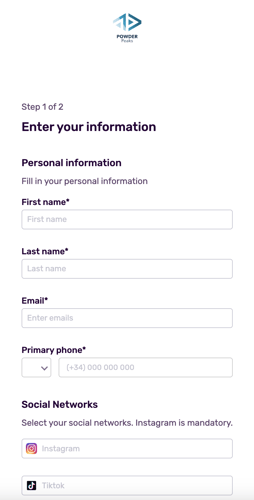
Once the landing page was created, the second step was to spread it far and wide through the company’s existing social channels. In these posts, the company outlined 3 important details:
- The benefits - what influencers would get out of working with PowderPeaks.
- The responsibilities - what the company expected from the collaboration and the time commitment required.
- The persona - the skills, values, and experience they were looking for.
The landing page was a success, and within 1 week PowderPeaks had an additional 107 influencers to choose from. As before, they used the influencer analysis feature in the IRM to find the most high-performing influencers with relevant audiences.

Influencer Seeding Campaigns - Easy E-Commerce Integrations
Once the profiles were vetted for quality and authenticity, it was time to start the influencer seeding process.
Influencity users can create a product seeding program within the Campaigns product. In just a few steps, PowderPeaks was able to integrate their Shopify e-commerce store and create a program to seed their products:
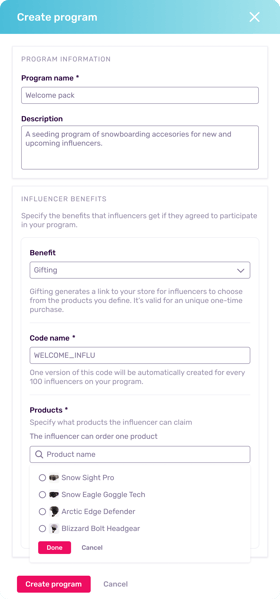
Once the store was integrated and the seeding program was created, the last step was to invite influencers and inform them about the seeding campaign. This was made easy with Influencity’s bulk email feature, which allowed them to use personalization tokens for a personal approach when working at scale.
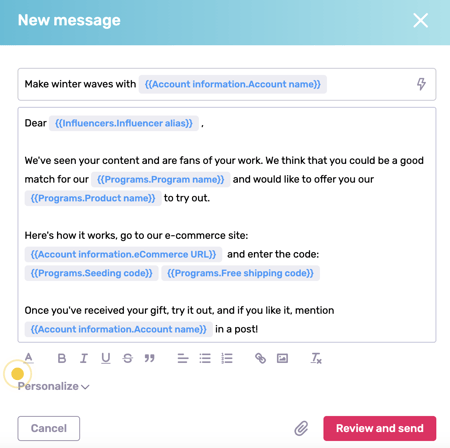
Influencers in the program would then receive a personalized email with all the information on where to go to request their gift, the code to use to redeem it, and instructions on how to share it on their social media profile.
Proving ROI - Influencer Reporting
Last but not least, PowderPeaks wanted to measure the return on investment of their efforts, to know if this type of campaign should be repeated in the future.
To do this, they simply made a list of all the posts where their brand and hashtags were mentioned, and included them in an Influencity report to see their performance. Influencity then analyzed all public post data and compiled it into an easily readable, easily shareable report.
Access to this key data made calculating ROI a breeze:
- Total audience impacted
- Engagement across all publications
- Aggregate earned media value for the campaign
- Cost per engagement
- Top-performing publications and the earned media value for each
- Engagement broken down by publication date and social network
- The location, age, and gender of the audience impacted, as well as their city, language and ethnicity (In the case of posts on Instagram)
Conclusion
When PowderPeaks first started working with an influencer marketing platform, they had pain points to solve. To conclude, let’s review these points and the solution Influencity offered for each one.
Sourcing and Vetting Influencers
Previously, this was a time-consuming task, with searches taking 45 minutes for only 4-5 results and vetting taking at least 10-15 minutes per profile. Two solutions were offered for the search problem: the ability to search through a large database and zero in on the desired profiles with AI-powered filters, and the ability to create a recruitment landing page to attract the influencers who already follow the brand. Let's take a look at the difference:
- With Influencity's search feature, PowderPeaks was able to create a shortlist of 18 profiles in just 20 minutes. That's a reduction of 77%, meaning the team had more time to dedicate to other marketing tasks.
- As for the recruitment landing page, in just 1 week the company was able to attract 107 influencers. If vetted manually spending 10 minutes per profile, it would have taken almost 18 hours to thoroughly examine each profile. However, with Influencity's at-a-glance performance dashboards, this time was reduced to just 3 minutes per profile or 5.5 hours. A reduction of 70%!
Combatting Seasonality
By starting in late summer, PowderPeaks had a solid database of effective influencers by early September. This meant they could get their seeding program rolling and start building excitement around their selected products well before the season started, increasing their autumn cash flow.
Low Customer Lifetime Value
By raising awareness about their new products through authentic influencer posts, PowderPeaks was able to increase both customer loyalty and average ticket price. As for the seeding campaign, Influencity helped PowderPeaks get more for their campaign dollars by improving influencer quality and response rate. This was due to:
- Interest - since many of the influencers were recruited through a landing page, they already knew the brand and were eager to collaborate.
- Intent - influencers have to go to the brand’s e-commerce site and enter a code to redeem the gift. This intent means they are interested in the gift and therefore likely to promote it.
- Simplification - when influencers are invited to take part in a seeding program, you use their email to add them as “customers” in your online store. Therefore, when they open your page and enter your code, their checkout process is exactly as it would be for any other customer in your e-commerce store – no need for your team to waste time packaging and sending seeding products.
If a normal response rate for an influencer seeding campaign is 30%, PowderPeaks was able to increase the response rate by 34 points, meaning 64% of the influencers contacted to participate in the seeding program responded favorably. That's almost double the response rate.
Of this 64%, 40% uploaded 2-3 posts featuring PowderPeaks products, meaning authentic, relatable, and engaging user-generated content that could be reposted by the brand.
Browse our blog posts, eBooks, and more
eBook
Influencer Outreach Guide: How to Connect, Negotiate and Set Clear Campaign Goals
Download now
Blog Post
How to Market Your Business on Social Media: 10 Tips that Can Help You Sell More
Read more
eBook
Influencer Marketing: The Ultimate Guide to Campaign Planning, Execution, and ROI
Download nowNo results found.

